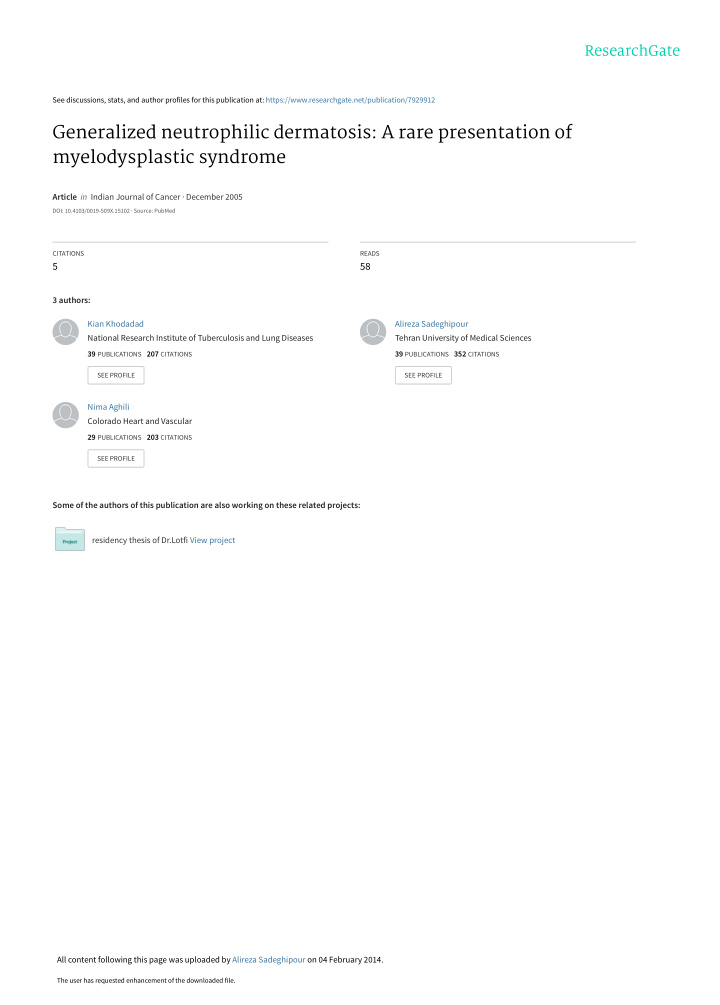



See discussions, stats, and author profiles for this publication at: https://www.researchgate.net/publication/7929912 Generalized neutrophilic dermatosis: A rare presentation of myelodysplastic syndrome Article in Indian Journal of Cancer · December 2005 DOI: 10.4103/0019-509X.15102 · Source: PubMed CITATIONS READS 5 58 3 authors: Kian Khodadad Alireza Sadeghipour National Research Institute of Tuberculosis and Lung Diseases Tehran University of Medical Sciences 39 PUBLICATIONS 207 CITATIONS 39 PUBLICATIONS 352 CITATIONS SEE PROFILE SEE PROFILE Nima Aghili Colorado Heart and Vascular 29 PUBLICATIONS 203 CITATIONS SEE PROFILE Some of the authors of this publication are also working on these related projects: residency thesis of Dr.Lotfi View project All content following this page was uploaded by Alireza Sadeghipour on 04 February 2014. The user has requested enhancement of the downloaded file.
Case Generalized neutrophilic dermatosis: A rare Report presentation of myelodysplastic syndrome Khodadad Kian, Sadeghipour Alireza, Aghili Nima National Institute of Tuberculosis and Lung Diseases, Oncology Department, *Iran Medical School. Baghi Hospital, Iran Correspondence to: Dr. Aghili Nima, E-mail: nima_aghili@yahoo.com Abstract We present a 30-year-old man admitted with generalized cutaneous lesions, fever and cough. Examination of skin biopsies of a papular lesion revealed dense neutrophilic infiltration of the upper dermis, so these lesions were diagnosed as neutrophilic dermatosis. Peripheral blood examination and bone marrow findings confirmed the diagnosis of myelodysplastic syndrome with excess blasts. The cutaneous lesions improved after administration of corticosteroid and follow-up bone marrow examination revealed a normocellular marrow. One year later he referred with acute myelogenous leukemia (AML-M0). Unfortunately, he did not respond to treatment and died a few months later due to disease progression. Key Words: Sweet's syndrome, neutrophilic dermatosis, myelodysplastic syndrome Introduction generalized neutrophilic dermatosis as a presenting symptom. Myelodysplastic syndrome (MDS) refers to a group of Case History clonal stem cell disorders characterized by maturation defects, resulting in ineffective hematopoiesis and an increased risk of transformation to AML. A 30-year-old man, non-smoker, with no significant previous medical illness, admitted to our hospital with Some patients with MDS develop skin eruptions. skin lesions of one month duration and two weeks These lesions are classified as either specific or non- history of dry cough and fever. The patient’s drug specific. [1] Specific leukemic infiltrates, often referred history was not informative. to as leukemia cutis, and non-specific inflammatory lesions, historically called leukemids, include dermal On physical examination body temperature was 38.7C vasculitis, cutaneous infections, neutrophilic and numerous tender, erythematous-based, dermatosis and panniculitis. Based on previous vesiculopapular and postular lesions were detected on reports neutrophilic dermatosis occurs as single or the face, chest wall, upper extremities, anterior and multiple skin eruptions during the course of the posterior trunk and proximal lower extremities, some of disease or treatment. But developing as generalized which were crusted or ulcerated (Figure 1). No mucosal lesions which precedes other findings has not yet involvement was present. On chest examination, been reported. breathing sounds were decreased at both lung bases. There was no palpable lymphadenopathy or We describe a patient with MDS who developed hepatosplenomegaly. Indian Journal of Cancer | January - March 2005 | Volume 42 | Issue 1 53
Khodadad et al: Generalized neutrophilic dermatosis (b) (a) Figures 1a and 1 b: Erythematous-based, vesiculopapular and postular lesions on chest and abdomen The initial laboratory investigation yielded the following therefore he was discharged from the hospital with oral results: Hgb: 8.9 gr/dl, Plt: 180x10 9 / L , WBC: 7.8x10 9 / prednisolon (20 mg/day). On follow-up, bone marrow L , with a differential count of 85% neutrophils and examination was normocellular. 10% lymphocytes and ESR: 55 mm/h. One year later he referred with high-grade fever, fatigue, Chest X-ray showed bilateral lower lobes infiltration. weakness and anorexia. Routine laboratory evaluation showed anemia (Hb: 10.8 gr/dl), leukocytosis (WBC:123x10 9 / L ) with 30% blasts and low platelet Gram stain and tissue culture examinations from a bulla (78x10 9 / L ) count. Bone marrow examination revealed were negative for microorganisms. marked hypercellular marrow containing more than 90% Skin biopsy of a papule demonstrated irregular myeloblasts which were negative for all cytochemical acanthosis, spongiosis and upper dermal infiltration of stains (MPO, SBB, NSE and P AS). acute and chronic inflammatory cells which was accompanied by exocytosis and dense neutrophilic Immunophenotyping showed CD 45 positive leukemic infiltration, and the lower dermis showed perivascular lymphocytic infiltration, so these lesions were identified as neutrophilic dermatosis (Figure 2). Peripheral blood examination showed leukoerythroblastic reaction with nuclear hypo- or hypersegmentation of neutrophilic series, accompanied by 5% myeloblasts. Considering persistent fever and appearance of blasts in peripheral blood, bone marrow examination was performed. Microscopic examination revealed marked hypercellular marrow with dysmyelopoietic changes and increased percentage of myeloblasts, which account for 15% of marrow cells. Systemic antibiotics (cloxacilin and ceftazidim) were started but the skin lesions were resistant to antibiotic therapy. After a week, based on the pathology report of neutrophilic dermatosis, prednisolone (60 mg/day) was administered. After 20 days, the patient responded dramatically and Figure 2: Skin biopsy showing upper dermal dense neutrophilic infiltration most of the skin lesions disappeared completely; 54 Indian Journal of Cancer | January - March 2005 | Volume 42 | Issue 1
Recommend
More recommend